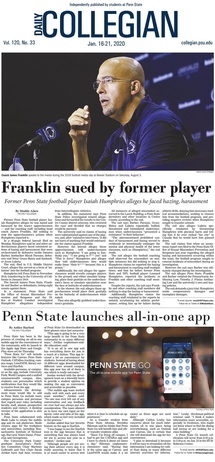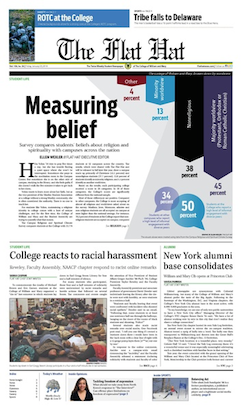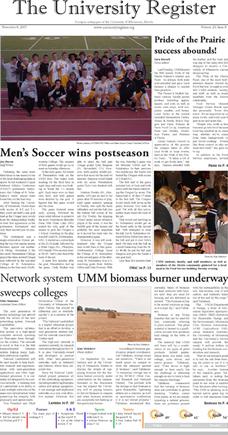Related Research Articles

The Technique, also known as the "'Nique", is the official student newspaper of the Georgia Institute of Technology in Atlanta, Georgia, and has referred to itself as "the South's liveliest college newspaper" since 1945. As of the fall semester of 2011, the Technique has a weekly circulation of 10,000, distributed to numerous locations on the Georgia Tech campus and a handful of locations in the surrounding area. The first issue of the Technique was published on November 17, 1911, and the paper has printed continuously since its founding. The paper publishes weekly throughout the regular school year and primarily covers news, events and issues specific to the Georgia Tech community. In 2004 it was one of 25 collegiate newspapers to receive the Pacemaker award from the Associated Collegiate Press.

The Daily Collegian is a student-produced news outlet, with a newspaper and website, that is published independently at the Pennsylvania State University. The newspaper is printed once a week during the fall and spring semesters, and not at all during the summer semester. It is distributed for free at the University Park campus as well as mailed to subscribers across the country.

The Hoya, founded in 1920, is the oldest and largest student newspaper of Georgetown University in Washington, D.C., serving as the university’s newspaper of record. The Hoya is a student-run paper that prints every Friday and publishes online daily throughout the year, with a print circulation of 4,000 during the academic year. The newspaper has four main editorial sections: News, Opinion, Sports and The Guide, a weekly arts and lifestyle magazine. It also publishes several annual special issues including a New Student Guide, a basketball preview and a semesterly fashion issue.
The Parthenon is the independent student newspaper of Marshall University based in Huntington, West Virginia. The paper began publication in 1898. It currently is published in print on Tuesdays with content added daily online. It is distributed for "free" on the Huntington and South Charleston campuses. The Parthenon is also published online. Student reporters change every semester and are instructed by the faculty adviser in a beat reporting class within the school of journalism. Editors, staff reporters and other staff change annually or every semester.

The Student Life is a student newspaper covering the Claremont Colleges, a consortium of liberal arts colleges in Claremont, California. It is published weekly each Friday during the academic year, typically spans roughly ten pages per issue, and is primarily funded by the student governments of the colleges.

The Flat Hat is the official student newspaper at the College of William and Mary in Williamsburg, Virginia. It prints Tuesdays during the College's academic year. It began printing twice-weekly in 2007; since its inception in 1911, The Flat Hat had printed weekly. It returned to weekly printing in 2015. In fall 2020, The Flat Hat began printing biweekly due to restrictions associated with the COVID-19 pandemic. The Flat Hat staff operates out of its office in William and Mary's Sadler Center.
The Daily Trojan, or "DT," is the student newspaper of the University of Southern California. The newspaper is a forum for student expression and is written, edited, and managed by university students. The paper is intended to inform USC students, faculty, and staff on the latest news and provide opinion and entertainment. Student writers, editors, photographers and artists can develop their talents and air their opinions while providing a service to the campus community through the Daily Trojan. Readers can interact with the Daily Trojan by commenting on articles online or writing a letter to the editor.
The State Press is the independent, student-operated news publication of Arizona State University. In August 2014, it became an all-digital publication. It published a free newspaper every weekday until January 2013, at which point its print distribution was reduced to once per week. The editorial board announced that ASU Student Media will begin to focus on "a host of new digital products and special print products."
The Daily Free Press is the independent student newspaper at Boston University. It is a digital-first publication with daily online content and a monthly print edition on Thursday during the academic year. The Daily Free Press is staffed by about 200 volunteer editors, writers, reporters and photographers. The editorial positions change on a semester-to-semester basis. The paper is governed by a board of former editors, who make up the Board of Directors of Back Bay Publishing Co., Inc., a Massachusetts non-profit.
The Fairfield Mirror is the student newspaper of Fairfield University in Fairfield, Connecticut. It is a student-run publication that publishes weekly on Wednesdays during the academic year with additional issues during commencement and orientation. The Mirror staff has won numerous Excellence in Journalism Awards from the Connecticut Society of Professional Journalists.
The Daily Targum is the official student newspaper of Rutgers, the State University of New Jersey. Founded in 1867, it is the second-oldest collegiate newspaper in the United States. The Daily Targum is student written and managed, and boasts a circulation of 5,000 in 2017. In its current form, it exists as a bi-fold tabloid-style paper featuring international, national, local, and university news, as well as editorials, columns, comics, classifieds, sports, and other amusements. In 1980, the paper achieved independence from the University, establishing a non-profit organization, the Targum Publishing Company, which now oversees all areas of the paper. The Daily Targum is published Monday through Friday while classes are in session, in New Brunswick, New Jersey.
The State News is the student newspaper of Michigan State University in East Lansing, Michigan. It is supported by a combination of advertising revenue and a $7.50 refundable tax that students pay at each semester's matriculation. Though The State News is supported by a student tax, the faculty and administration do not interfere in the paper's content. The State News is governed by a Board of Directors, which comprises journalism professionals, faculty and students. In 2010, the Princeton Review ranked The State News as the #8 best college newspaper in the country. And in 2015, the Society of Professional Journalists named TSN as the nation's best daily college newspaper for 2014.
The Daily Gamecock is the editorially independent student news organization of the University of South Carolina. It primarily serves the main campus of the University of South Carolina System in the state of South Carolina.
The Medium a student newspaper in the United States. It is a student-run weekly satire and comedy publication at Rutgers University, the state university of New Jersey. Founded in 1970 as The Livingston Medium, it is the second largest newspaper in circulation at Rutgers University, after the official student newspaper, The Daily Targum. Referring to itself as the "Entertainment Weekly of Rutgers University", the more recent incarnations of The Medium focus on satirical and humorous articles based on current events, popular culture, and events on the Rutgers campuses. Since 1970, the newspaper has been headquartered on Livingston Campus.

The University Register (UR) is the official campus newspaper of the University of Minnesota Morris, and is published bi-weekly during the academic year. It primarily serves the University of Minnesota Morris campus and the greater Morris community. The paper is entirely student-run, operating out of the basement of the school's Multi-Ethnic Resource Center, and distributes over 1,500 copies to the campus every Thursday night. A typical issue of The UR is between fourteen and eighteen pages long, and consists of five sections: News, Editorial, Arts & Entertainment, Variety, and a Feature.
The Rocky Mountain Collegian is the daily student newspaper of Colorado State University. Founded in 1891, the paper is one of the oldest daily student newspapers west of the Mississippi River and is the only student-run daily newspaper in the state of Colorado. In 2010, the Collegian was ranked one of the top three daily student newspapers in the nation by the Society of Professional Journalists.
The Daily Evergreen is the student newspaper for Washington State University.

The Central Florida Future was the independent weekly student newspaper of the University of Central Florida in Orlando, Florida. The Future was one of the largest student-run newspapers in the United States, with a circulation of 14,000 and readership of over 30,000. It was a member of the USA Today network.

The Montana Kaimin is the University of Montana's student-run independent newspaper located in Missoula, Montana. The paper is printed once a week, Thursday, with special editions printed occasionally and is online at MontanaKaimin.com. The Kaimin covers news, sports, arts and culture, and opinion.
The Massachusetts Daily Collegian is an American daily newspaper founded in 1890, and the independently funded, student-operated newspaper of the University of Massachusetts Amherst. The Collegian is a non-profit funded entirely through advertising revenue and receives no funding from the university or from student fees. In 2018, the Collegian scaled back its print edition to one issue per month, with digital-only articles continuing to be released daily.